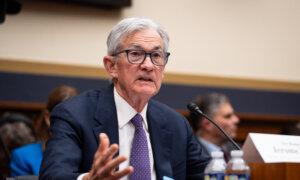“While the economy entered a period of heightened uncertainty this year, the underlying data through the first quarter showed resilience,” Jefferson said.
Real gross domestic product contracted slightly—by 0.3 percent—on an annualized basis in the first quarter of 2025, but Jefferson pointed to strong consumer demand and a three percent rise in private domestic final purchases as signs of underlying momentum.
He said recent tariff announcements and shifting federal policies have increased economic uncertainty and forced him to revise his growth forecast downward. Still, Jefferson said he expects the economy to keep expanding, noting that the ultimate effect of policy changes remains to be seen.
“Various surveys show a decline in business sentiment related to trade policy,” he said, referencing concerns among manufacturers and retailers over rising costs and potential supply disruptions. “Uncertainty is quite high.”
Labor market conditions remain solid, Jefferson said. The unemployment rate stood at 4.2 percent in April and has hovered in a narrow range since mid-2024. Employers added 177,000 jobs last month, and layoff rates remain historically low.
Jefferson also cited a notable shift in job market dynamics. The ratio of job vacancies to unemployed workers has declined from its 2022 peak of 2-to-1 to a 1-to-1 ratio as of March, signaling what he described as a balanced labor market with limited inflationary pressure.
Inflation has continued to ease, though it remains above the Fed’s 2 percent target. The personal consumption expenditures (PCE) price index rose 2.3 percent year-over-year in March. Core PCE inflation, which excludes food and energy, was 2.6 percent.
Jefferson warned that sustained increases in tariffs could slow progress on inflation, at least temporarily. He said it’s unclear whether those effects will be short-lived or more persistent, depending on policy implementation and how businesses respond.
“Most measures of longer-run inflation expectations have been largely stable,” he said, suggesting that the American people “understand” the Federal Reserve’s policy moves.
Jefferson reaffirmed support for the Federal Open Market Committee’s recent decision to keep interest rates steady, noting that the current stance is “moderately restrictive” and gives the Fed room to respond to changes in the economic outlook.
“Our monetary policy actions are guided by our dual mandate to promote maximum employment and stable prices for the American people,” he said. “With the increased risks to both sides of our mandate, I believe that the current stance of monetary policy is well-positioned to respond in a timely way to potential economic developments.”
Jefferson closed by emphasizing the importance of local insights from business leaders and advisers, who help shape policy decisions by reporting on conditions in their communities.
“The uncertain economic outlook presents a challenge for monetary policymakers,” he said.
“Effective policymaking starts with hearing from people in every corner of this country.”







